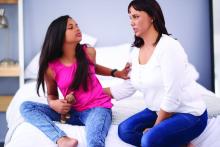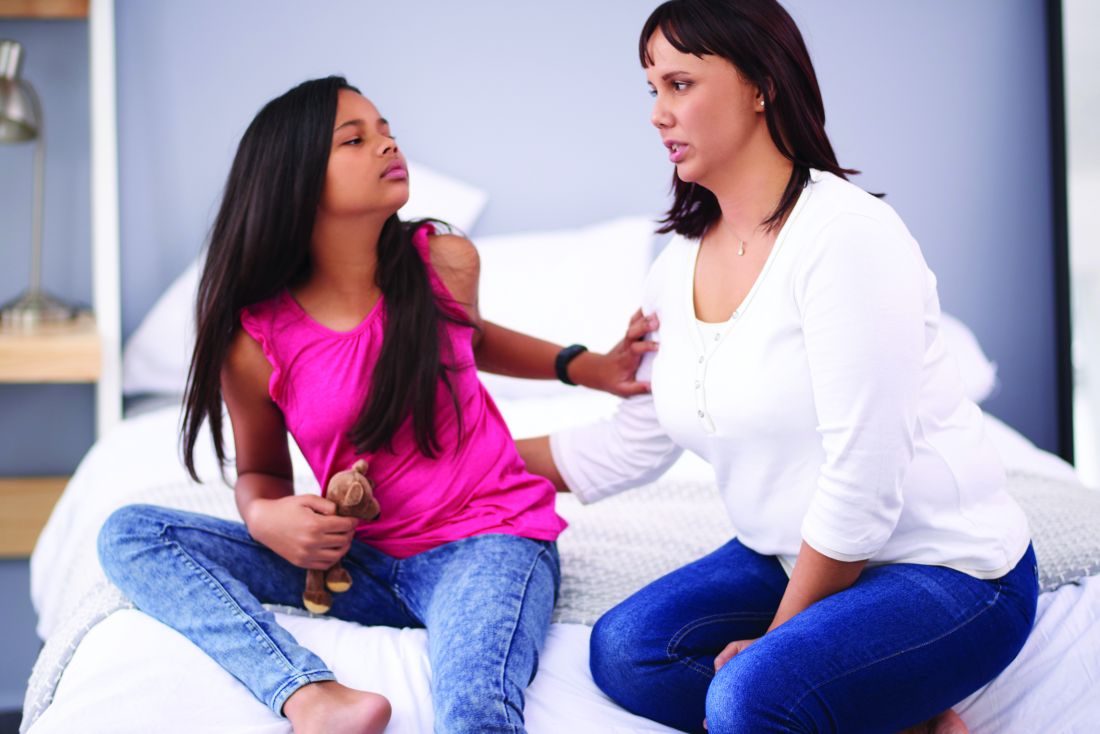User login
An alarming number of bipolar disorder diagnoses or something else?
During a particularly busy day in my inpatient and outpatient practice, I realized that nearly every one of the patients had been given the diagnosis of bipolar disorder at one point or another. The interesting thing is this wasn’t an unusual day.
Nearly all of my patients and their family members have been given the diagnosis of bipolar disorder. Because prevalence of bipolar affective disorders is a little over 2%, this seemed a little odd. Could there be an epidemic of bipolar disorder in the area? Should someone sound the alarm on this unique cluster and get Julia Roberts ready? Unfortunately, the story behind this mystery is a little less sexy but nevertheless interesting.
When I probe more into what symptoms might have led to the diagnosis of bipolar disorder, I most often get some sort of answer about being easily angered (“I’m fine 1 minute and the next minute I’m yelling at my mom”) or mood changing from 1 minute to the next. Rarely do they tell me about sleeping less, increased energy, change in mood (elation, anger, irritability), increase in activity level, and increased pleasurable though dangerous activities all happening around the same time(s). So what is going on?
Beginning in the 1990s, a debate about the phenotypic presentation of pediatric bipolar disorder polarized the field. It was theorized that mania could present with severe nonepisodic irritability with extended periods of very rapid mood cycling within the day as opposed to discrete episodic mood cycles in children and adolescents. With this broader conceptualization in the United States, the rate of bipolar diagnosis increased by over 40 times in less than a decade.1 Similarly, the use of mood stabilizers and atypical antipsychotics in children also rose substantially.2
To help assess if severe nonepisodic irritability belongs in the spectrum of bipolar disorders, the National Institutes of Mental Health proposed a syndrome called “Severe Mood Dysregulation” or SMD, to promote the study of children with this phenotype. In longitudinal studies, Stringaris et al. compared rates of manic episodes in youth with SMD versus bipolar disorder over 2 years and found only one youth (1%) with SMD who presented with manic, hypomanic, or mixed episodes, compared with 58 (62%) with bipolar disorder.3 Leibenluft et al.showed that chronic irritability during early adolescence predicted ADHD at late adolescence and major depressive disorder in early adulthood whereas episodic irritability predicted mania.4 Twenty-year follow-up of the same sample showed chronic irritability in adolescence predicted dysthymia, generalized anxiety disorders, and major depressive disorder.5 Other longitudinal studies essentially have shown the same results.6
At this point, the question of whether chronic irritability is a part of the bipolar spectrum disorder is largely resolved – 7 The diagnosis emphasizes the episodic nature of the illness, and that irritability would wax and wane with other manic symptoms such as changes in energy and sleep. And the ultrarapid mood changes (mood changes within the day) appear to describe mood fluctuations within a manic episode as opposed to each change being a separate episode.
So, most likely, my patients were caught in a time of uncertainty before data were able to clarify their phenotype.
Dr. Chung is a child and adolescent psychiatrist at the University of Vermont Medical Center, Burlington, and practices at Champlain Valley Physician’s Hospital in Plattsburgh, N.Y. Email him at [email protected].
References
1. Biol Psychiatry. 2007 Jul 15;62(2):107–14.
2. JAMA Psychiatry. 2015 Sep;72(9):859-60.
3. J Am Acad Child Adolesc Psychiatry. 2010 Apr;49(4):397-405.
4. J Child Adolesc Psychopharmacol 2006;16(4):456-66.
5. Am J Psychiatry. 2009 Sep;166(9):1048-54.
6. Biol Psychiatry. 2006 Nov 1;60(9):991-7.
7. Bipolar Disord. 2017 Nov;19(7):524-43.
During a particularly busy day in my inpatient and outpatient practice, I realized that nearly every one of the patients had been given the diagnosis of bipolar disorder at one point or another. The interesting thing is this wasn’t an unusual day.
Nearly all of my patients and their family members have been given the diagnosis of bipolar disorder. Because prevalence of bipolar affective disorders is a little over 2%, this seemed a little odd. Could there be an epidemic of bipolar disorder in the area? Should someone sound the alarm on this unique cluster and get Julia Roberts ready? Unfortunately, the story behind this mystery is a little less sexy but nevertheless interesting.
When I probe more into what symptoms might have led to the diagnosis of bipolar disorder, I most often get some sort of answer about being easily angered (“I’m fine 1 minute and the next minute I’m yelling at my mom”) or mood changing from 1 minute to the next. Rarely do they tell me about sleeping less, increased energy, change in mood (elation, anger, irritability), increase in activity level, and increased pleasurable though dangerous activities all happening around the same time(s). So what is going on?
Beginning in the 1990s, a debate about the phenotypic presentation of pediatric bipolar disorder polarized the field. It was theorized that mania could present with severe nonepisodic irritability with extended periods of very rapid mood cycling within the day as opposed to discrete episodic mood cycles in children and adolescents. With this broader conceptualization in the United States, the rate of bipolar diagnosis increased by over 40 times in less than a decade.1 Similarly, the use of mood stabilizers and atypical antipsychotics in children also rose substantially.2
To help assess if severe nonepisodic irritability belongs in the spectrum of bipolar disorders, the National Institutes of Mental Health proposed a syndrome called “Severe Mood Dysregulation” or SMD, to promote the study of children with this phenotype. In longitudinal studies, Stringaris et al. compared rates of manic episodes in youth with SMD versus bipolar disorder over 2 years and found only one youth (1%) with SMD who presented with manic, hypomanic, or mixed episodes, compared with 58 (62%) with bipolar disorder.3 Leibenluft et al.showed that chronic irritability during early adolescence predicted ADHD at late adolescence and major depressive disorder in early adulthood whereas episodic irritability predicted mania.4 Twenty-year follow-up of the same sample showed chronic irritability in adolescence predicted dysthymia, generalized anxiety disorders, and major depressive disorder.5 Other longitudinal studies essentially have shown the same results.6
At this point, the question of whether chronic irritability is a part of the bipolar spectrum disorder is largely resolved – 7 The diagnosis emphasizes the episodic nature of the illness, and that irritability would wax and wane with other manic symptoms such as changes in energy and sleep. And the ultrarapid mood changes (mood changes within the day) appear to describe mood fluctuations within a manic episode as opposed to each change being a separate episode.
So, most likely, my patients were caught in a time of uncertainty before data were able to clarify their phenotype.
Dr. Chung is a child and adolescent psychiatrist at the University of Vermont Medical Center, Burlington, and practices at Champlain Valley Physician’s Hospital in Plattsburgh, N.Y. Email him at [email protected].
References
1. Biol Psychiatry. 2007 Jul 15;62(2):107–14.
2. JAMA Psychiatry. 2015 Sep;72(9):859-60.
3. J Am Acad Child Adolesc Psychiatry. 2010 Apr;49(4):397-405.
4. J Child Adolesc Psychopharmacol 2006;16(4):456-66.
5. Am J Psychiatry. 2009 Sep;166(9):1048-54.
6. Biol Psychiatry. 2006 Nov 1;60(9):991-7.
7. Bipolar Disord. 2017 Nov;19(7):524-43.
During a particularly busy day in my inpatient and outpatient practice, I realized that nearly every one of the patients had been given the diagnosis of bipolar disorder at one point or another. The interesting thing is this wasn’t an unusual day.
Nearly all of my patients and their family members have been given the diagnosis of bipolar disorder. Because prevalence of bipolar affective disorders is a little over 2%, this seemed a little odd. Could there be an epidemic of bipolar disorder in the area? Should someone sound the alarm on this unique cluster and get Julia Roberts ready? Unfortunately, the story behind this mystery is a little less sexy but nevertheless interesting.
When I probe more into what symptoms might have led to the diagnosis of bipolar disorder, I most often get some sort of answer about being easily angered (“I’m fine 1 minute and the next minute I’m yelling at my mom”) or mood changing from 1 minute to the next. Rarely do they tell me about sleeping less, increased energy, change in mood (elation, anger, irritability), increase in activity level, and increased pleasurable though dangerous activities all happening around the same time(s). So what is going on?
Beginning in the 1990s, a debate about the phenotypic presentation of pediatric bipolar disorder polarized the field. It was theorized that mania could present with severe nonepisodic irritability with extended periods of very rapid mood cycling within the day as opposed to discrete episodic mood cycles in children and adolescents. With this broader conceptualization in the United States, the rate of bipolar diagnosis increased by over 40 times in less than a decade.1 Similarly, the use of mood stabilizers and atypical antipsychotics in children also rose substantially.2
To help assess if severe nonepisodic irritability belongs in the spectrum of bipolar disorders, the National Institutes of Mental Health proposed a syndrome called “Severe Mood Dysregulation” or SMD, to promote the study of children with this phenotype. In longitudinal studies, Stringaris et al. compared rates of manic episodes in youth with SMD versus bipolar disorder over 2 years and found only one youth (1%) with SMD who presented with manic, hypomanic, or mixed episodes, compared with 58 (62%) with bipolar disorder.3 Leibenluft et al.showed that chronic irritability during early adolescence predicted ADHD at late adolescence and major depressive disorder in early adulthood whereas episodic irritability predicted mania.4 Twenty-year follow-up of the same sample showed chronic irritability in adolescence predicted dysthymia, generalized anxiety disorders, and major depressive disorder.5 Other longitudinal studies essentially have shown the same results.6
At this point, the question of whether chronic irritability is a part of the bipolar spectrum disorder is largely resolved – 7 The diagnosis emphasizes the episodic nature of the illness, and that irritability would wax and wane with other manic symptoms such as changes in energy and sleep. And the ultrarapid mood changes (mood changes within the day) appear to describe mood fluctuations within a manic episode as opposed to each change being a separate episode.
So, most likely, my patients were caught in a time of uncertainty before data were able to clarify their phenotype.
Dr. Chung is a child and adolescent psychiatrist at the University of Vermont Medical Center, Burlington, and practices at Champlain Valley Physician’s Hospital in Plattsburgh, N.Y. Email him at [email protected].
References
1. Biol Psychiatry. 2007 Jul 15;62(2):107–14.
2. JAMA Psychiatry. 2015 Sep;72(9):859-60.
3. J Am Acad Child Adolesc Psychiatry. 2010 Apr;49(4):397-405.
4. J Child Adolesc Psychopharmacol 2006;16(4):456-66.
5. Am J Psychiatry. 2009 Sep;166(9):1048-54.
6. Biol Psychiatry. 2006 Nov 1;60(9):991-7.
7. Bipolar Disord. 2017 Nov;19(7):524-43.
Promoting a child’s resilience
As an inpatient child psychiatrist, I see children with some of the most difficult emotional and behavioral issues. And among them, children with adverse childhood experiences (ACE) make up a significant portion. But early childhood adversity is common not just among children who present to the hospital. In the landmark ACE study, which was an ongoing collaboration between Kaiser Permanente and the Centers for Disease Control and Prevention to assess impact of ACEs on various health outcomes, 40% percent of the participants reported experiencing two or more ACEs.1 Subsequent studies have shown even higher numbers. The study by Copeland et al. on traumatic events based on the Great Smokey Mountains Study showed that more than two-thirds of children reported at least one traumatic event by the age of 16 years.2
The significance of this finding cannot be overstated. It is clear that the cumulative incidences of ACEs are associated with poorer health outcomes in a graded dose-response relationship. Those exposed are at great risk of developing PTSD, ADHD, mood disorders, anxiety disorders, and substance use disorder.3 Furthermore, they also are at risk for developing asthma, obesity, ischemic heart disease, diabetes, chronic obstructive pulmonary disease, autoimmune disease, and sexually transmitted disease.4 They have lower quality of life, use more health care services, and die nearly 20 years younger.5
Currently, the biology of adverse childhood experiences is being elucidated. The deleterious effects of chronically elevated cortisol leading to smaller hippocampal volume through atrophy, neurotoxicity, and disruption of neurogenesis has been demonstrated in adults, but children and adolescents have been found to have reduced medial and posterior corpus callosum.6-10 Other alterations include changes in EEG activity, and dysregulation of the sympathetic nervous system.11-13 New systems or neuropeptides that could potentially be beneficial in the treatment of trauma include tempering down of the locus coeruleus–norepinephrine system, the anxiolytic effect of neuropeptide Y, and brain-derived neurotrophic factor.14,15
Despite all the progress, the treatment for trauma remains imperfect. Depending on the presenting symptoms, stimulants, alpha-agonists (guanfacine or clonidine), alpha-1 blocker, and/or SSRIs all could be a good first step. Medication could reduce the burden of some of the symptoms, but its effects are limited. During the 1970s, researchers started noticing that some children were able to thrive despite substantial risk factors for mental illness. This led to research identifying individual and environmental factors that could be protective against ACEs.
So, what is resilience? It is the development of positive adaptations in the context of significant adversity.16 But this ability is not purely incumbent on the child. The individual characteristics that lead to resilience such as internal locus of control, optimism, and determination also are dependent on their environment. As such, it is a complex dynamic interplay of genetics, temperament, experience, and environmental supports. As much as the environment can affect resilience, this gives us opportunities to help the child be more resilient, perhaps before an adverse event happens.
One, emphasize the family! A strong family relationship is among the most robust predictor of resilient adaptation. Early experiences and attachments will shape the lens through which people view their subsequent relationships and place them on probabilistic trajectories of “relatively good or bad adaptation.”17 And just what constitutes “good parenting”? The authoritative parenting style that balances appropriate controls and warmth with consistency and responsiveness generally lead to better outcomes.18 Other important features include reasonable limit-setting, monitoring, and containment.19, 20 Clinicians with expertise in one of the parent-coaching manuals (i.e., “Helping the Noncompliant Child,” by McMahon and Forehand; and “Your Defiant Child: Eight Steps to Better Behavior,” by Barkley and Benton and others) can be helpful in answering parenting questions whether individually or in the group setting.
In addition, parental mental health issues also can adversely affect family relationships. Based on previous studies, mothers who suffer from depression have more difficulty being responsive and warm to their child.21 They are often times more punitive and less consistent. Children of mothers with depression are at risk for internalizing, externalizing, and general psychopathology.22 Mothers with history of ACEs are less able to modulate stress and model coping skills. As such, it can be just as important to screen the parents for mental health issues and refer to the appropriate clinician.
Two, community supports also can facilitate development of resilience. Studies have shown participants in the Big Brothers and Big Sisters programs of America exhibit more positive behavior such as better academic behaviors, better relationships with family and friends, and decreased substance use.23 Furthermore, studies on minority students (African American and Hispanic) suggest improved relationship with teachers led to less behavioral problems and improved social competence. Religious affiliations and other social supports can serve similar purposes as well.24
Three, keep in mind the malleability of the child. Many child attributes are dependent on environmental influences and resilience should focus more on what adults can do to bolster the child’s own efforts.
Dr. Chung is a child and adolescent psychiatrist at the University of Vermont Medical Center, Burlington, and practices at Champlain Valley Physician’s Hospital in Plattsburgh, N.Y. Email him at [email protected].
References
1. Am J Prev Med. 1998 May;14(4):245-58.
2. Arch Gen Psychiatry. 2007 May;64(5):577-84.
3. Eur Arch Psychiatry Clin Neurosci. 2006 Apr;256(3):174-86.
4. Am J Prev Med. 1998 May;14(4):245-58.
5. Pediatr Res. 2016 Jan;79(1-2):227-33.
6. Prog Neuropsychopharmacol Biol Psychiatry. 2010 Oct 1;34(7):1181-8.
7. Brain Res. 1992 Aug 21;588(2):341-5.
8. J Neurosci. 1985 May;5(5):1222-7.
9. J Comp Neurol. 1996 May 20;369(1):56-63.
10. Biol Psychiatry. 2002 Dec 1;52(11):1066-78.
11. J Neuropsychiatry Clin Neurosci. 1998 Summer;10(3):298-307.
12. Biol Psychiatry. 2002 Apr 1;51(7):575-82.
13. Brain Res. 2009 Oct 13;1293:13-23.
14. Neuropeptides. 2016 Apr;56:19-24.
15. Cell. 2007 Oct 19;131(2):391-404.
16. Child Dev. 2000; 71(3): 543-62.
17. Lewis’s Child and Adolescent Psychiatry: A Comprehensive Textbook, 4th ed. (Baltimore: Lippincott Williams & Wilkins, 2007)
18. Early Hum Dev. 2010 Nov;86(11):689-93.
19. Clin Child Fam Psychol Rev. 1998 Mar;1(1):61-75.
20. Dev Psychopathol. 2003 Winter;15(1):95-117.
21. Clin Psychol Rev. 2000 Aug;20(5):561-92.
22. Clin Child Fam Psychol Rev. 2011 Mar;14(1):1-27.
23. “Making a Difference: An Impact Study of Big Brothers Big Sisters,” (Philadelphia: Public/Private Ventures, 1995).
24. Child Dev. 2003 Nov-Dec;74(6):1682-96.
As an inpatient child psychiatrist, I see children with some of the most difficult emotional and behavioral issues. And among them, children with adverse childhood experiences (ACE) make up a significant portion. But early childhood adversity is common not just among children who present to the hospital. In the landmark ACE study, which was an ongoing collaboration between Kaiser Permanente and the Centers for Disease Control and Prevention to assess impact of ACEs on various health outcomes, 40% percent of the participants reported experiencing two or more ACEs.1 Subsequent studies have shown even higher numbers. The study by Copeland et al. on traumatic events based on the Great Smokey Mountains Study showed that more than two-thirds of children reported at least one traumatic event by the age of 16 years.2
The significance of this finding cannot be overstated. It is clear that the cumulative incidences of ACEs are associated with poorer health outcomes in a graded dose-response relationship. Those exposed are at great risk of developing PTSD, ADHD, mood disorders, anxiety disorders, and substance use disorder.3 Furthermore, they also are at risk for developing asthma, obesity, ischemic heart disease, diabetes, chronic obstructive pulmonary disease, autoimmune disease, and sexually transmitted disease.4 They have lower quality of life, use more health care services, and die nearly 20 years younger.5
Currently, the biology of adverse childhood experiences is being elucidated. The deleterious effects of chronically elevated cortisol leading to smaller hippocampal volume through atrophy, neurotoxicity, and disruption of neurogenesis has been demonstrated in adults, but children and adolescents have been found to have reduced medial and posterior corpus callosum.6-10 Other alterations include changes in EEG activity, and dysregulation of the sympathetic nervous system.11-13 New systems or neuropeptides that could potentially be beneficial in the treatment of trauma include tempering down of the locus coeruleus–norepinephrine system, the anxiolytic effect of neuropeptide Y, and brain-derived neurotrophic factor.14,15
Despite all the progress, the treatment for trauma remains imperfect. Depending on the presenting symptoms, stimulants, alpha-agonists (guanfacine or clonidine), alpha-1 blocker, and/or SSRIs all could be a good first step. Medication could reduce the burden of some of the symptoms, but its effects are limited. During the 1970s, researchers started noticing that some children were able to thrive despite substantial risk factors for mental illness. This led to research identifying individual and environmental factors that could be protective against ACEs.
So, what is resilience? It is the development of positive adaptations in the context of significant adversity.16 But this ability is not purely incumbent on the child. The individual characteristics that lead to resilience such as internal locus of control, optimism, and determination also are dependent on their environment. As such, it is a complex dynamic interplay of genetics, temperament, experience, and environmental supports. As much as the environment can affect resilience, this gives us opportunities to help the child be more resilient, perhaps before an adverse event happens.
One, emphasize the family! A strong family relationship is among the most robust predictor of resilient adaptation. Early experiences and attachments will shape the lens through which people view their subsequent relationships and place them on probabilistic trajectories of “relatively good or bad adaptation.”17 And just what constitutes “good parenting”? The authoritative parenting style that balances appropriate controls and warmth with consistency and responsiveness generally lead to better outcomes.18 Other important features include reasonable limit-setting, monitoring, and containment.19, 20 Clinicians with expertise in one of the parent-coaching manuals (i.e., “Helping the Noncompliant Child,” by McMahon and Forehand; and “Your Defiant Child: Eight Steps to Better Behavior,” by Barkley and Benton and others) can be helpful in answering parenting questions whether individually or in the group setting.
In addition, parental mental health issues also can adversely affect family relationships. Based on previous studies, mothers who suffer from depression have more difficulty being responsive and warm to their child.21 They are often times more punitive and less consistent. Children of mothers with depression are at risk for internalizing, externalizing, and general psychopathology.22 Mothers with history of ACEs are less able to modulate stress and model coping skills. As such, it can be just as important to screen the parents for mental health issues and refer to the appropriate clinician.
Two, community supports also can facilitate development of resilience. Studies have shown participants in the Big Brothers and Big Sisters programs of America exhibit more positive behavior such as better academic behaviors, better relationships with family and friends, and decreased substance use.23 Furthermore, studies on minority students (African American and Hispanic) suggest improved relationship with teachers led to less behavioral problems and improved social competence. Religious affiliations and other social supports can serve similar purposes as well.24
Three, keep in mind the malleability of the child. Many child attributes are dependent on environmental influences and resilience should focus more on what adults can do to bolster the child’s own efforts.
Dr. Chung is a child and adolescent psychiatrist at the University of Vermont Medical Center, Burlington, and practices at Champlain Valley Physician’s Hospital in Plattsburgh, N.Y. Email him at [email protected].
References
1. Am J Prev Med. 1998 May;14(4):245-58.
2. Arch Gen Psychiatry. 2007 May;64(5):577-84.
3. Eur Arch Psychiatry Clin Neurosci. 2006 Apr;256(3):174-86.
4. Am J Prev Med. 1998 May;14(4):245-58.
5. Pediatr Res. 2016 Jan;79(1-2):227-33.
6. Prog Neuropsychopharmacol Biol Psychiatry. 2010 Oct 1;34(7):1181-8.
7. Brain Res. 1992 Aug 21;588(2):341-5.
8. J Neurosci. 1985 May;5(5):1222-7.
9. J Comp Neurol. 1996 May 20;369(1):56-63.
10. Biol Psychiatry. 2002 Dec 1;52(11):1066-78.
11. J Neuropsychiatry Clin Neurosci. 1998 Summer;10(3):298-307.
12. Biol Psychiatry. 2002 Apr 1;51(7):575-82.
13. Brain Res. 2009 Oct 13;1293:13-23.
14. Neuropeptides. 2016 Apr;56:19-24.
15. Cell. 2007 Oct 19;131(2):391-404.
16. Child Dev. 2000; 71(3): 543-62.
17. Lewis’s Child and Adolescent Psychiatry: A Comprehensive Textbook, 4th ed. (Baltimore: Lippincott Williams & Wilkins, 2007)
18. Early Hum Dev. 2010 Nov;86(11):689-93.
19. Clin Child Fam Psychol Rev. 1998 Mar;1(1):61-75.
20. Dev Psychopathol. 2003 Winter;15(1):95-117.
21. Clin Psychol Rev. 2000 Aug;20(5):561-92.
22. Clin Child Fam Psychol Rev. 2011 Mar;14(1):1-27.
23. “Making a Difference: An Impact Study of Big Brothers Big Sisters,” (Philadelphia: Public/Private Ventures, 1995).
24. Child Dev. 2003 Nov-Dec;74(6):1682-96.
As an inpatient child psychiatrist, I see children with some of the most difficult emotional and behavioral issues. And among them, children with adverse childhood experiences (ACE) make up a significant portion. But early childhood adversity is common not just among children who present to the hospital. In the landmark ACE study, which was an ongoing collaboration between Kaiser Permanente and the Centers for Disease Control and Prevention to assess impact of ACEs on various health outcomes, 40% percent of the participants reported experiencing two or more ACEs.1 Subsequent studies have shown even higher numbers. The study by Copeland et al. on traumatic events based on the Great Smokey Mountains Study showed that more than two-thirds of children reported at least one traumatic event by the age of 16 years.2
The significance of this finding cannot be overstated. It is clear that the cumulative incidences of ACEs are associated with poorer health outcomes in a graded dose-response relationship. Those exposed are at great risk of developing PTSD, ADHD, mood disorders, anxiety disorders, and substance use disorder.3 Furthermore, they also are at risk for developing asthma, obesity, ischemic heart disease, diabetes, chronic obstructive pulmonary disease, autoimmune disease, and sexually transmitted disease.4 They have lower quality of life, use more health care services, and die nearly 20 years younger.5
Currently, the biology of adverse childhood experiences is being elucidated. The deleterious effects of chronically elevated cortisol leading to smaller hippocampal volume through atrophy, neurotoxicity, and disruption of neurogenesis has been demonstrated in adults, but children and adolescents have been found to have reduced medial and posterior corpus callosum.6-10 Other alterations include changes in EEG activity, and dysregulation of the sympathetic nervous system.11-13 New systems or neuropeptides that could potentially be beneficial in the treatment of trauma include tempering down of the locus coeruleus–norepinephrine system, the anxiolytic effect of neuropeptide Y, and brain-derived neurotrophic factor.14,15
Despite all the progress, the treatment for trauma remains imperfect. Depending on the presenting symptoms, stimulants, alpha-agonists (guanfacine or clonidine), alpha-1 blocker, and/or SSRIs all could be a good first step. Medication could reduce the burden of some of the symptoms, but its effects are limited. During the 1970s, researchers started noticing that some children were able to thrive despite substantial risk factors for mental illness. This led to research identifying individual and environmental factors that could be protective against ACEs.
So, what is resilience? It is the development of positive adaptations in the context of significant adversity.16 But this ability is not purely incumbent on the child. The individual characteristics that lead to resilience such as internal locus of control, optimism, and determination also are dependent on their environment. As such, it is a complex dynamic interplay of genetics, temperament, experience, and environmental supports. As much as the environment can affect resilience, this gives us opportunities to help the child be more resilient, perhaps before an adverse event happens.
One, emphasize the family! A strong family relationship is among the most robust predictor of resilient adaptation. Early experiences and attachments will shape the lens through which people view their subsequent relationships and place them on probabilistic trajectories of “relatively good or bad adaptation.”17 And just what constitutes “good parenting”? The authoritative parenting style that balances appropriate controls and warmth with consistency and responsiveness generally lead to better outcomes.18 Other important features include reasonable limit-setting, monitoring, and containment.19, 20 Clinicians with expertise in one of the parent-coaching manuals (i.e., “Helping the Noncompliant Child,” by McMahon and Forehand; and “Your Defiant Child: Eight Steps to Better Behavior,” by Barkley and Benton and others) can be helpful in answering parenting questions whether individually or in the group setting.
In addition, parental mental health issues also can adversely affect family relationships. Based on previous studies, mothers who suffer from depression have more difficulty being responsive and warm to their child.21 They are often times more punitive and less consistent. Children of mothers with depression are at risk for internalizing, externalizing, and general psychopathology.22 Mothers with history of ACEs are less able to modulate stress and model coping skills. As such, it can be just as important to screen the parents for mental health issues and refer to the appropriate clinician.
Two, community supports also can facilitate development of resilience. Studies have shown participants in the Big Brothers and Big Sisters programs of America exhibit more positive behavior such as better academic behaviors, better relationships with family and friends, and decreased substance use.23 Furthermore, studies on minority students (African American and Hispanic) suggest improved relationship with teachers led to less behavioral problems and improved social competence. Religious affiliations and other social supports can serve similar purposes as well.24
Three, keep in mind the malleability of the child. Many child attributes are dependent on environmental influences and resilience should focus more on what adults can do to bolster the child’s own efforts.
Dr. Chung is a child and adolescent psychiatrist at the University of Vermont Medical Center, Burlington, and practices at Champlain Valley Physician’s Hospital in Plattsburgh, N.Y. Email him at [email protected].
References
1. Am J Prev Med. 1998 May;14(4):245-58.
2. Arch Gen Psychiatry. 2007 May;64(5):577-84.
3. Eur Arch Psychiatry Clin Neurosci. 2006 Apr;256(3):174-86.
4. Am J Prev Med. 1998 May;14(4):245-58.
5. Pediatr Res. 2016 Jan;79(1-2):227-33.
6. Prog Neuropsychopharmacol Biol Psychiatry. 2010 Oct 1;34(7):1181-8.
7. Brain Res. 1992 Aug 21;588(2):341-5.
8. J Neurosci. 1985 May;5(5):1222-7.
9. J Comp Neurol. 1996 May 20;369(1):56-63.
10. Biol Psychiatry. 2002 Dec 1;52(11):1066-78.
11. J Neuropsychiatry Clin Neurosci. 1998 Summer;10(3):298-307.
12. Biol Psychiatry. 2002 Apr 1;51(7):575-82.
13. Brain Res. 2009 Oct 13;1293:13-23.
14. Neuropeptides. 2016 Apr;56:19-24.
15. Cell. 2007 Oct 19;131(2):391-404.
16. Child Dev. 2000; 71(3): 543-62.
17. Lewis’s Child and Adolescent Psychiatry: A Comprehensive Textbook, 4th ed. (Baltimore: Lippincott Williams & Wilkins, 2007)
18. Early Hum Dev. 2010 Nov;86(11):689-93.
19. Clin Child Fam Psychol Rev. 1998 Mar;1(1):61-75.
20. Dev Psychopathol. 2003 Winter;15(1):95-117.
21. Clin Psychol Rev. 2000 Aug;20(5):561-92.
22. Clin Child Fam Psychol Rev. 2011 Mar;14(1):1-27.
23. “Making a Difference: An Impact Study of Big Brothers Big Sisters,” (Philadelphia: Public/Private Ventures, 1995).
24. Child Dev. 2003 Nov-Dec;74(6):1682-96.




